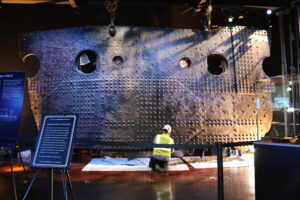Exploring the Titanic: The 2024 Titanic Expedition and Beyond

The RMS Titanic remains one of the most iconic ships in history. Its tragic sinking on its maiden voyage in 1912 captured global attention and has continued to fascinate people for over a century. RMS Titanic Inc. plays a crucial role in exploring and preserving the Titanic’s legacy. Their upcoming 2024 Titanic expedition promises new discoveries and insights into the ship’s current condition.
The Titanic’s Ill-Fated Voyage
The Titanic was a marvel of early 20th-century engineering. Built by Harland and Wolff in Belfast, the ship was the largest and most luxurious ocean liner of its time. The Titanic embarked on its maiden voyage from Southampton to New York City in April 1912. On the night of April 14, 1912, disaster struck.
The Titanic collided with an iceberg, leading to its sinking in the early hours of April 15. More than 1,500 passengers and crew lost their lives in one of the deadliest maritime disasters in history. The tragedy highlighted significant shortcomings in maritime safety regulations and led to reforms to improve safety at sea.
Discovery of the Titanic Wreck
For decades, the location of the Titanic’s wreck remained a mystery. Numerous attempts to locate the wreck using sonar technology were unsuccessful. In 1985, a breakthrough came when a joint French-American expedition, led by Jean-Louis Michel and Robert Ballard, discovered the wreck.
This expedition, initially searching for two sunken nuclear submarines, stumbled upon the Titanic. The discovery of the wreck provided invaluable insights into the ship’s final moments and its current state on the ocean floor.
RMS Titanic Inc. and Their Role
RMS Titanic Inc. holds exclusive rights as the salvor-in-possession of the Titanic wreck. Their mission is to preserve the legacy of the Titanic through exploration, recovery, and education. Over the years, RMS Titanic Inc. has undertaken several significant expeditions to document and recover artifacts from the wreck site. These missions have contributed greatly to our understanding of the Titanic and its historical significance.
Significant Finds from Past Expeditions
Since the initial discovery, RMS Titanic Inc. has conducted eight major expeditions to the Titanic wreck site. Each mission has yielded important discoveries and recovered significant artifacts.

The 1987 expedition marked the first major recovery effort. Using advanced technology, including the manned submersible Nautile, the team recovered approximately 1,800 objects. Among these were instruments from the stern Docking Bridge, a decorative cherub, and several leather pursers’ traveling bags.
In 1993, RMS Titanic Inc., in collaboration with IFREMER, undertook a second expedition using the French research vessel Nadir. This mission recovered around 800 artifacts, including the ship’s whistles, a double lifeboat davit, and a two-ton engine eccentric strap. Personal items such as a delicate jet bead and a child’s marbles were also retrieved.
The 1994 expedition, again in partnership with IFREMER, focused on recovering various personal effects and parts of the ship. Significant finds included a boot, binoculars, and a 17-ton section of the hull, which was carefully measured for later retrieval. These artifacts were later displayed at the National Maritime Museum in Greenwich.
The 1996 expedition was notable for its groundbreaking scientific studies. The team employed reverse engineering and forensic techniques to examine the ship’s deterioration. They studied the iron-consuming “rusticles” and recovered several important artifacts. The Discovery Channel documented this expedition, highlighting its scientific importance.
In 1998, RMS Titanic Inc. continued their Titanic explorations and discovered new debris fields. One of the most significant recoveries was a 17-ton section of the hull known as “The Big Piece.” This expedition also made history by providing the first live fiber-optic television broadcast from the ocean floor, allowing real-time exploration of the wreck.
The 2000 expedition utilized the Russian research vessel Keldysh and the submersibles MIR I and MIR II. This mission retrieved crucial artifacts such as the main wheel and steering stand from the docking bridge. A particularly remarkable find was 65 perfume vials belonging to a first-class passenger, which still emitted the scent of Edwardian perfume.
In 2004, the team shifted to using remotely operated vehicles (ROVs) for artifact recovery. Phoenix International’s ROVs enabled round-the-clock operations and detailed documentation of the recovery process. Among the unique artifacts recovered were a gilded wall sconce from the À la Carte Restaurant and a tile from the Turkish Bath.
The 2010 expedition was the most technologically advanced to date. The team employed innovative techniques to virtually raise the Titanic, gathering detailed images and data to preserve the ship’s legacy. This mission brought together leading archaeologists, oceanographers, and scientists, significantly enhancing our understanding of the Titanic’s historical and maritime importance.
The Current State of the Titanic Wreck Site
 The Titanic wreck lies at a depth of about 12,500 feet, approximately 370 nautical miles off the coast of Newfoundland. The wreck is divided into two main sections: the bow and the stern, which are about 2,000 feet apart.
The Titanic wreck lies at a depth of about 12,500 feet, approximately 370 nautical miles off the coast of Newfoundland. The wreck is divided into two main sections: the bow and the stern, which are about 2,000 feet apart.
The bow is relatively well-preserved, with many interiors still recognizable, despite damage from the impact with the sea floor. The stern, in contrast, is heavily damaged and collapsed. A debris field surrounds the wreck, containing countless items that fell from the ship as it sank.
Environmental conditions at such depths are harsh. The Titanic is subjected to strong ocean currents, high pressure, and low temperatures. These conditions contribute to the wreck’s gradual deterioration.
Biological factors, such as rust-eating bacteria, also play a significant role in the decay of the ship’s structure. The wreck is fragile, and efforts to raise it are not feasible due to its delicate state. The site is protected under a UNESCO convention to preserve it for future generations.
The 2024 Titanic Expedition
RMS Titanic Inc. is preparing for its next major expedition in July 2024. This will be their first return to the wreck site since 2010. The 2024 Titanic expedition has several key objectives: imaging, discovery, inspiration, and honoring the legacy.
The team aims to digitally record the current condition of the wreck. They will compare new images with those from 2010 to monitor changes and study the deterioration of the site, including the Marconi Wireless Room. This imaging effort is crucial for preserving the wreck’s existing state.
The discovery aspect involves investigating unexplored sections of the debris field to uncover new artifacts. The team also hopes to discover marine life that has not been observed before. Additionally, they will identify new areas of damage that might provide access to the ship’s interior.
Inspiration is another critical goal. RMS Titanic Inc. plans to engage the global community in identifying artifacts for future recovery. They aim to share the wreck site with the public through exhibitions, classrooms, and interactive experiences. By showcasing the excitement and importance of deep-sea exploration, they hope to encourage young people to pursue careers in oceanography, history, and related fields.
Honoring the legacy of the Titanic is a key objective of the expedition. The team will recognize the contributions of individuals like P.H. Nargeolet to Titanic research. They will continue the meticulous work of recovering and preserving artifacts to maintain the historical integrity of the site.
The 2024 expedition will utilize advanced technologies such as high-resolution photography and ROVs. These tools will help the team document the site in unprecedented detail and conduct thorough explorations. Key team members include experienced professionals in deep-sea exploration, marine biology, and archaeological conservation.
Education Initiatives and Public Interest
 RMS Titanic Inc. is committed to using recovered artifacts in educational programs. They integrate these artifacts into STEAM (Science, Technology, Engineering, Arts, and Mathematics) educational programs. These programs provide insightful lessons and inspire students to learn more about history and science. Virtual exhibitions and in-person field trips offer engaging learning experiences. The public can view artifacts and learn about the Titanic through permanent and touring exhibitions.
RMS Titanic Inc. is committed to using recovered artifacts in educational programs. They integrate these artifacts into STEAM (Science, Technology, Engineering, Arts, and Mathematics) educational programs. These programs provide insightful lessons and inspire students to learn more about history and science. Virtual exhibitions and in-person field trips offer engaging learning experiences. The public can view artifacts and learn about the Titanic through permanent and touring exhibitions.
The impact of Titanic exploration on public interest and historical education is significant. RMS Titanic Inc.’s efforts help keep the legacy of the Titanic alive for future generations. Their educational initiatives and public outreach programs ensure that the story of the Titanic continues to inspire and educate.
Follow RMS Titanic Inc. or Become a Member Today
Exploring the Titanic offers a unique glimpse into a pivotal moment in history. RMS Titanic Inc. plays an essential role in preserving this legacy through their expeditions and educational efforts. The upcoming 2024 expedition promises to provide valuable new insights into the wreck and contribute to ongoing conservation efforts.
By staying informed and involved, we can all help preserve the memory of the Titanic and its passengers. Follow RMS Titanic Inc. on social media and visit their website to get updates on the Titanic Expedition 2024. You can support their mission by donating, becoming a member, or visiting their exhibitions. Your involvement helps safeguard the legacy of the Titanic for future generations.
